Flexural Capability of Patterned Transparent Conductive Substrate by Performing Electrical Measurements and Stress Simulations
Abstract
:1. Introduction
2. Experimental Details of Patterned ITO/PET Films
2.1. Establishment of the Flexible Characteristic Inspection System and the Bending Experiment
2.2. Specimen Structure and Manufacture Process of Patterned ITO/PET Film
3. Experimental Results and Discussion
4. Stress–Strain Simulation Approach of Patterned ITO/PET Thin Films
4.1. Stress Distribution of Patterned ITO Film Deposited on a Compliant PET Substrate
4.2. Thickness Effect of ITO Coating
4.3. Pattern and Compliant PET Substrate Thickness Influence of ITO/PET Film
5. Conclusions
Acknowledgments
Author Contributions
Conflicts of Interest
References
- Baek, K.; Jang, K.; Lee, Y.J.; Ryu, K.; Choi, W.; Kim, D.; Yi, J. Improvement of mechanical reliability by patterned silver/Indium-Tin-Oxide structure for flexible electronic devices. Thin Solid Films 2013, 531, 349–353. [Google Scholar] [CrossRef]
- Alsaid, D.A.; Rebrosova, E.; Joyce, M.; Rebros, M.; Atashbar, M.; Bazuin, B. Gravure printing of ITO transparent electrodes for applications in flexible electronics. J. Disp. Technol. 2012, 8, 385–390. [Google Scholar] [CrossRef]
- Hui, Z.; Cho, E.S.; Kwon, S.J. Laser direct patterning of the T-shaped ITO electrode for high-efficiency alternative current plasma display panels. Appl. Surf. Sci. 2010, 257, 776–780. [Google Scholar]
- Pradeepkumar, M.S.; Sibin, K.P.; Swain, N.; Sridhara, N.; Dey, A.; Barshilia, H.C.; Sharma, A.K. Nanoindentation response of ITO film. Ceram. Int. 2015, 41, 8223–8229. [Google Scholar] [CrossRef]
- Kobayashi, T.; Ikeda, H.; Utsumi, Y.; Kanematsu, K.; Masuda, T.; Yamamoto, M. Measurement of reduced elastic modulus of organic semiconductor materials for flexible organic light emitting dioide. J. Jpn. Soc. Exp. Mech. 2014, 14, S194–S199. [Google Scholar]
- Cheng, H.; Wu, J.; Li, M.; Kim, Y.S.; Huang, Y.; Kang, Z.; Hwang, K.C.; Rogers, J.A. An analytical model of strain isolation for stretchable and flexible electronics. Appl. Phys. Lett. 2011, 98, 151904. [Google Scholar] [CrossRef]
- Wang, H.J.; Deng, H.A.; Chiang, S.Y.; Su, Y.F.; Chiang, K.N. Development of a process modeling for residual stress assessment of multilayer thin film structure. Thin Solid Films 2015, 584, 146–153. [Google Scholar] [CrossRef]
- Chen, Z.; Cotterell, B.; Wang, W.; Guenther, E.; Chua, S.J. A mechanical assessment of flexible optoelectronic devices. Thin Solid Films 2001, 394, 202–206. [Google Scholar] [CrossRef]
- Chen, Z.; Cotterell, B.; Wang, W. The fracture of brittle thin films on compliant substrates in flexible displays. Eng. Fract. Mech. 2002, 69, 597–603. [Google Scholar] [CrossRef]
- Li, T.C.; Han, C.F.; Chen, K.T.; Lin, J.F. Fatigue life study of ITO/PET specimens in terms of electrical resistance and stress/strain via cyclic bending tests. J. Disp. Technol. 2013, 9, 577–585. [Google Scholar] [CrossRef]
- Alzoubi, K.; Hamasha, M.M.; Lu, S.; Sammakia, B. Bending fatigue study of sputtered ITO on flexible substrate. J. Disp. Technol. 2011, 7, 593–600. [Google Scholar] [CrossRef]
- Huang, K.T.; Chen, H.C. Automatic measurement and stress analysis of ITO/PET flexible substrate by shadow moiré interferometer with phase-shifting interferometry. J. Disp. Technol. 2014, 10, 609–614. [Google Scholar] [CrossRef]
- Lin, H.K.; Chiu, S.M.; Cho, T.P.; Huang, J.C. Improved bending fatigue behavior of flexible PET/ITO film with thin metallic glass interlayer. Mater. Lett. 2013, 113, 182–185. [Google Scholar] [CrossRef]
- Lee, S.K.; Lee, J.U. The fracture distribution in ITO coating with compressive bending stress on polymer substrate. Trans. Electr. Electron. Mater. 2003, 4, 5–8. [Google Scholar] [CrossRef]
- Park, S.K.; Han, J.I.; Moon, D.G.; Kim, W.K. Mechanical stability of externally deformed indium–tin–oxide films on polymer substrates. Jpn. J. Appl. Phys. 2003, 42, 623–629. [Google Scholar] [CrossRef]
- Hamasha, M.M.; Alzoubi, K.; Lu, S. Behavior of sputtered indium–tin–oxide thin film on poly-ethylene terephthalate substrate under stretching. J. Disp. Technol. 2011, 7, 426–433. [Google Scholar] [CrossRef]
- Leterrier, Y.; Medico, L.; Demarco, F.; Manson, J.A.E.; Betz, U.; Escola, M.F.; Olsson, M.K.; Atamny, F. Mechanical integrity of transparent conductive oxide films for flexible polymer-based displays. Thin Solid Films 2004, 460, 156–166. [Google Scholar] [CrossRef]
- Guyot, N.; Harmand, Y.; Mezin, A. The role of the sample shape and size on the internal stress induced curvature of thin-film substrate systems. Int. J. Solids Struct. 2004, 41, 5143–5154. [Google Scholar] [CrossRef]
- Lee, C.C. Modeling and validation of mechanical stress in indium tin oxide layer integrated in highly flexible stacked thin films. Thin Solid Films 2013, 544, 443–447. [Google Scholar] [CrossRef]
- Wen, B.J.; Lee, C.C.; Hsu, J.S.; Huang, P.C.; Tsai, C.H. Investigation of optical and flexible characteristics for organic-based cholesteric liquid crystal display by utilizing bending and torsion loadings. J. Disp. Technol. 2015, 11, 682–688. [Google Scholar] [CrossRef]
- Crawford, G.P. Flexible Flat Panel Displays; Wiley: Chichester, UK, 2005; pp. 79–98. [Google Scholar]
- Hsu, J.S.; Lee, C.C.; Wen, B.J.; Huang, P.C.; Xie, C.K. Experimental and simulated investigations of thin polymer substrates with an indium tin oxide coating under fatigue bending loadings. Materials 2016, 9, 720. [Google Scholar] [CrossRef]
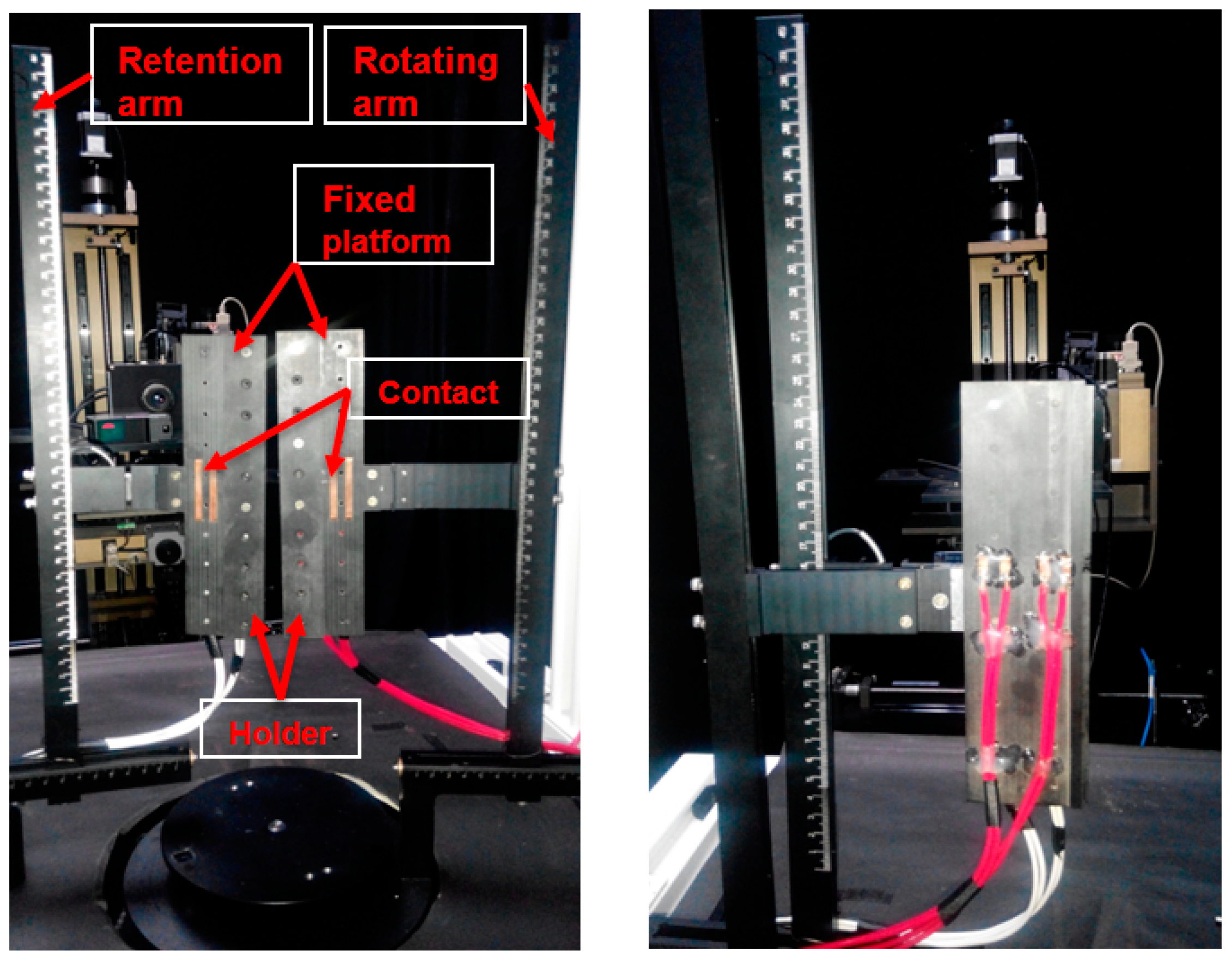
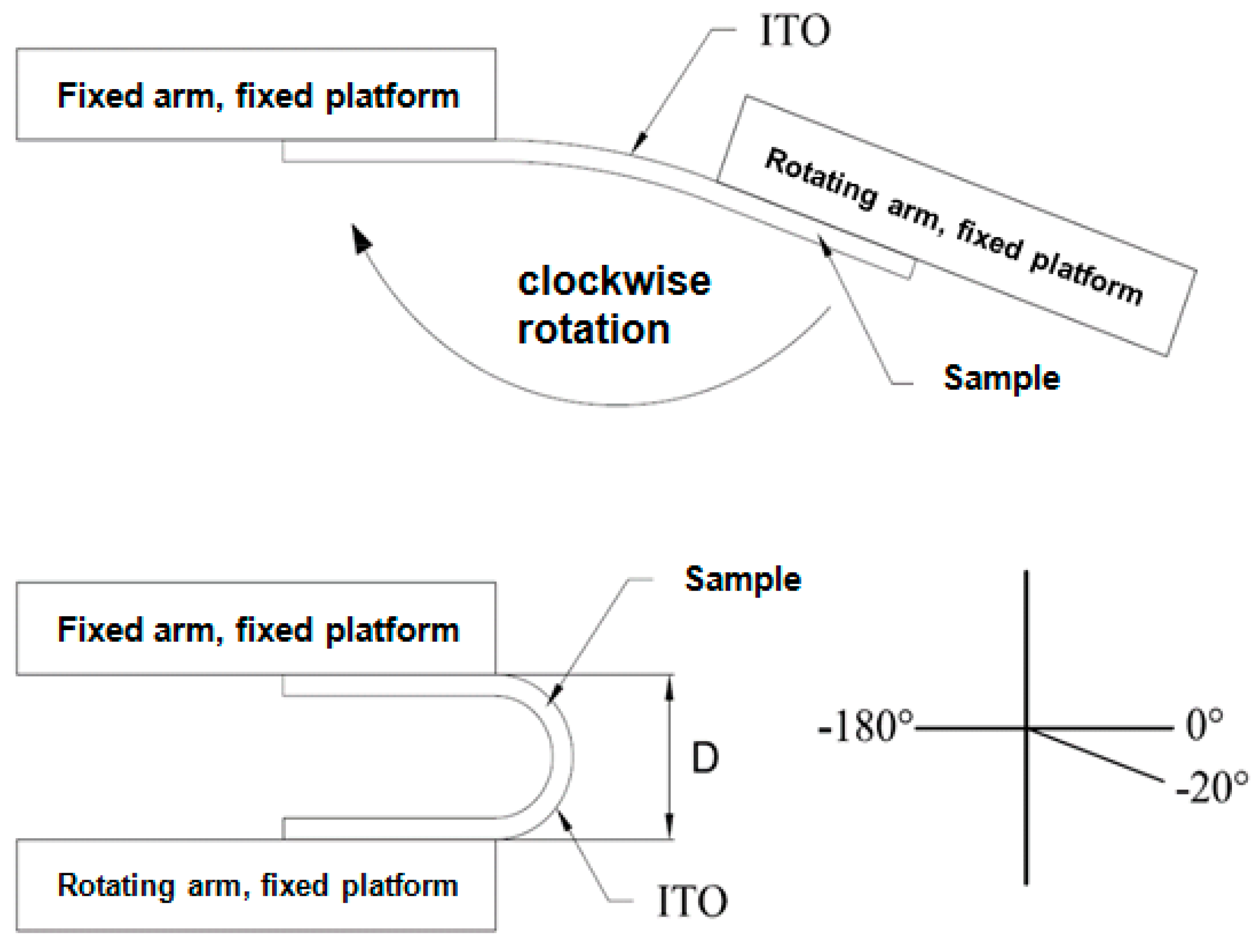
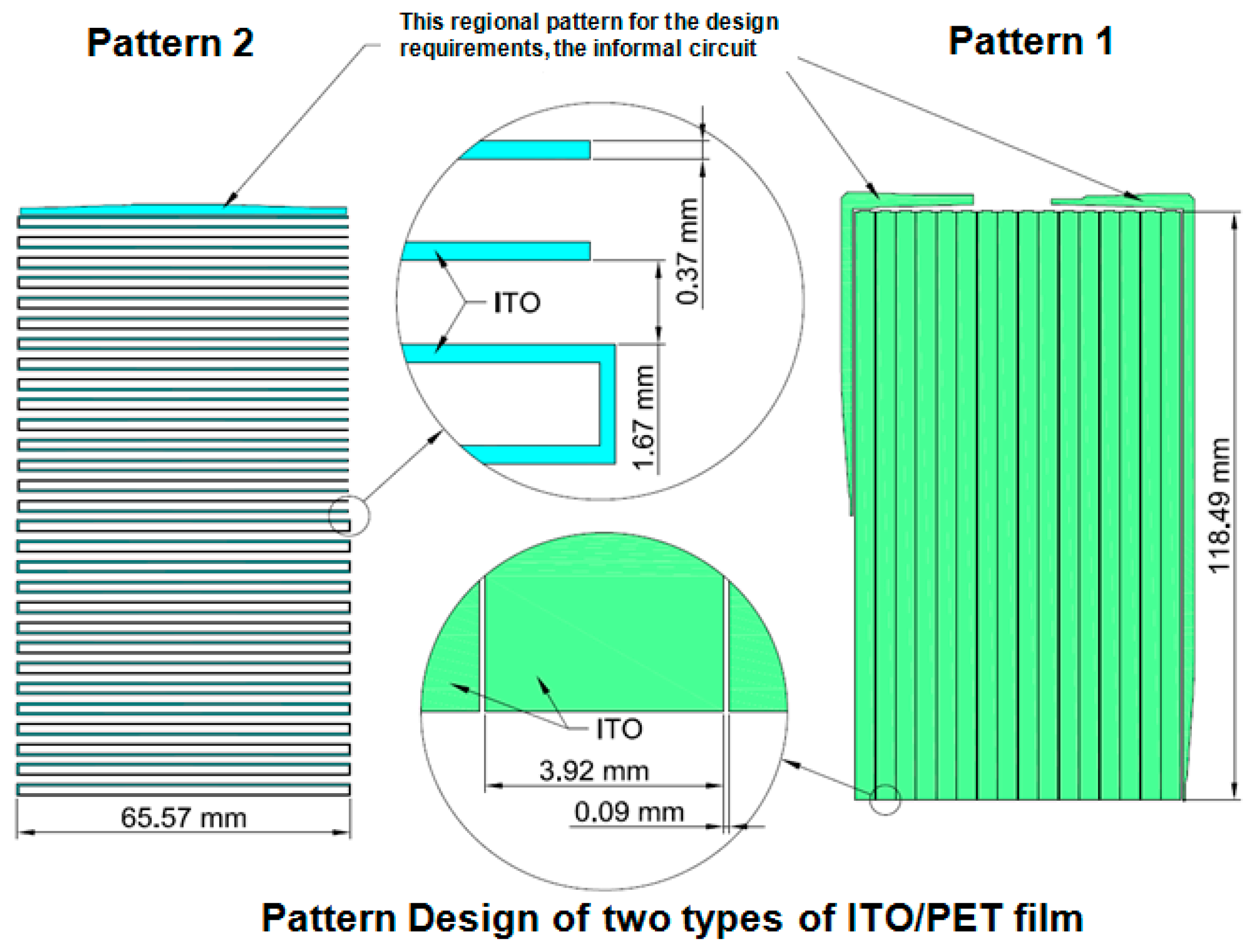
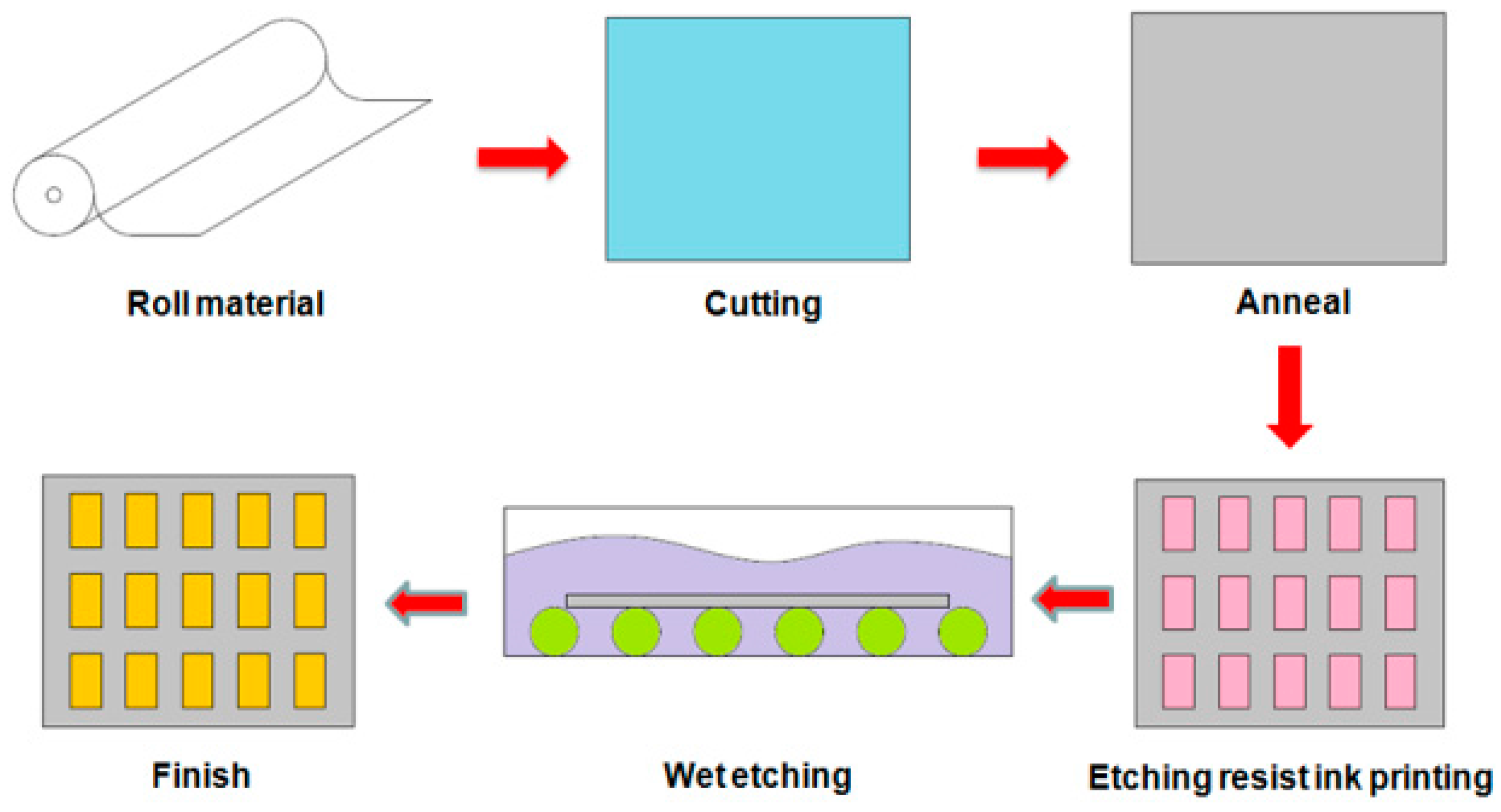
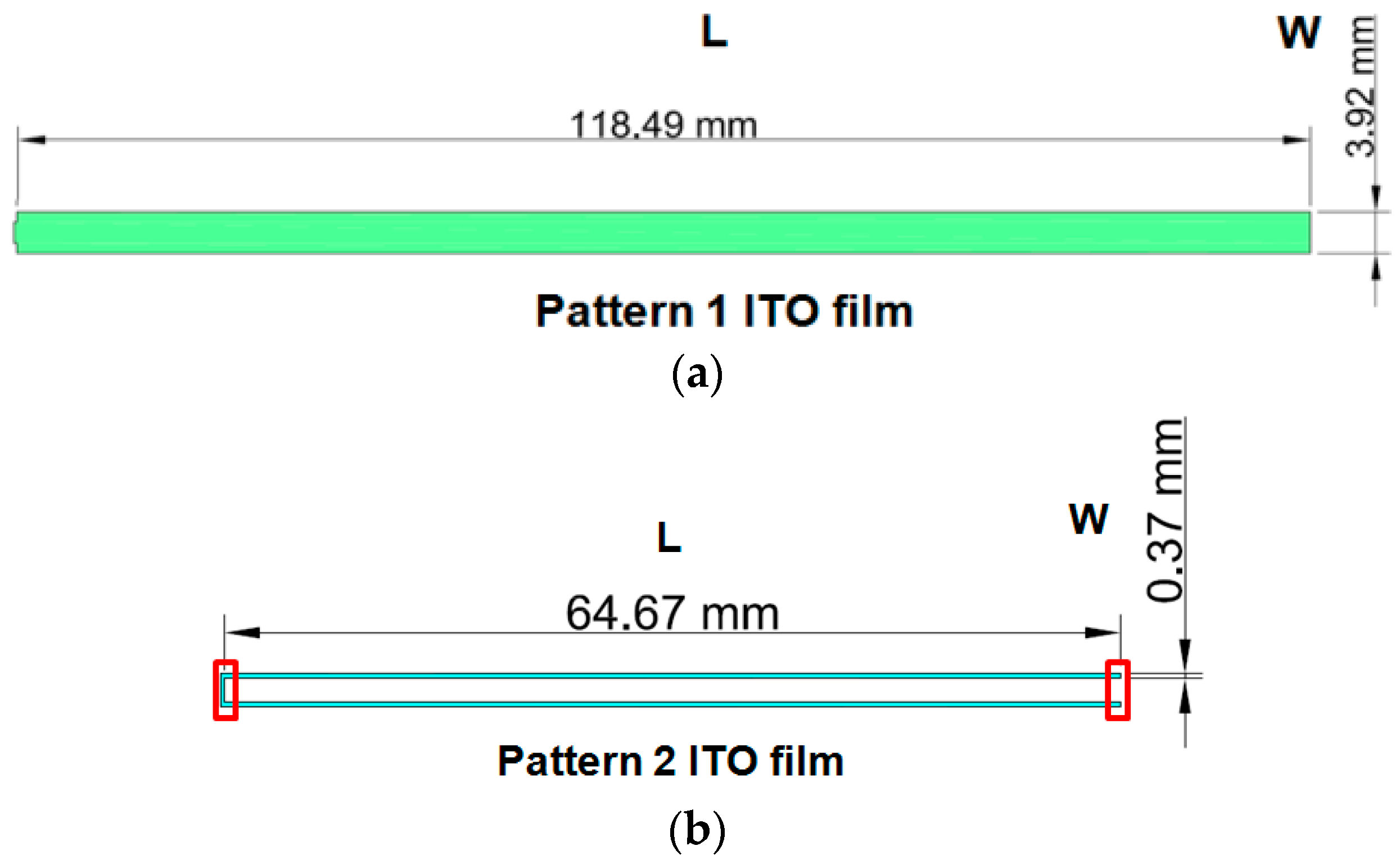
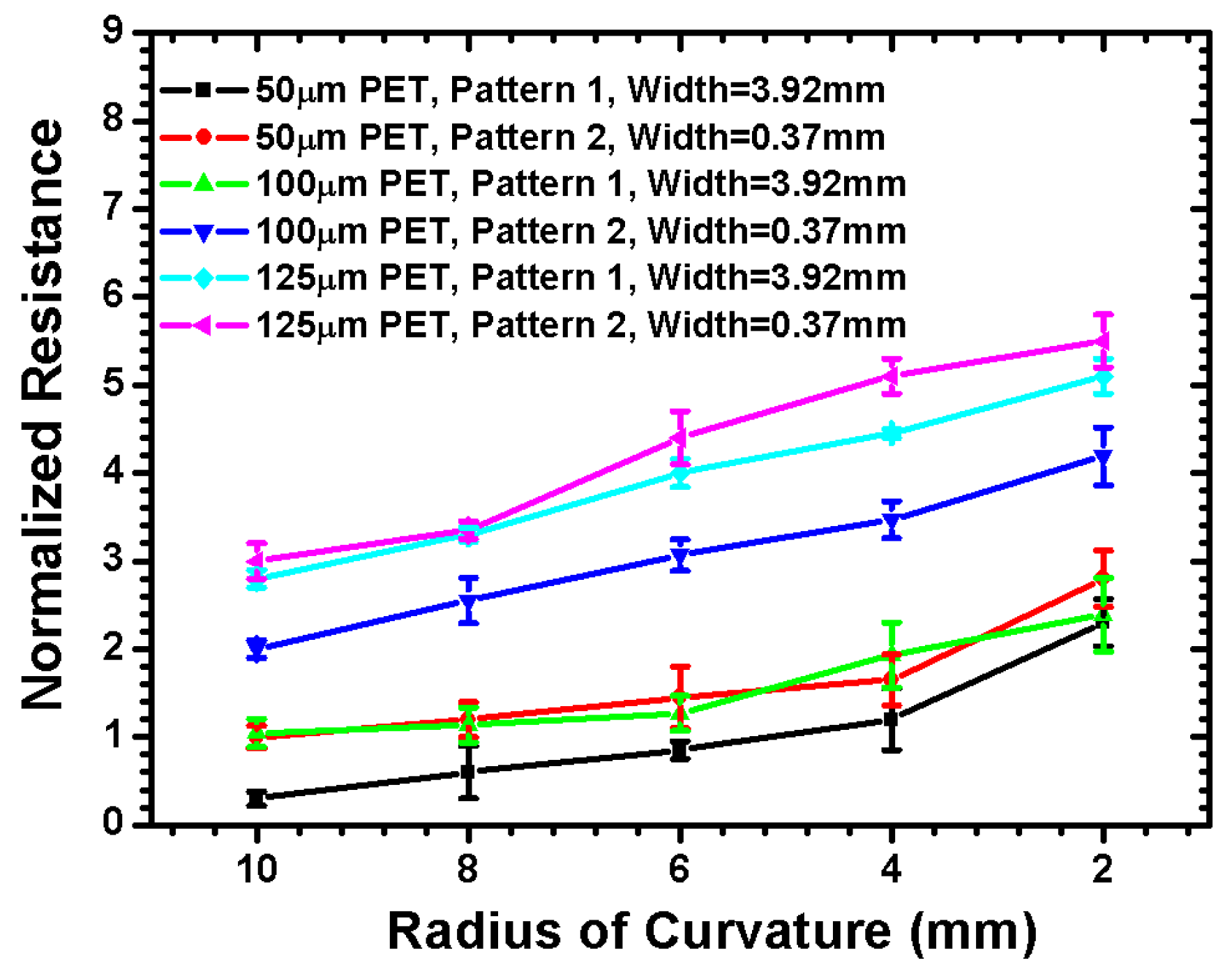
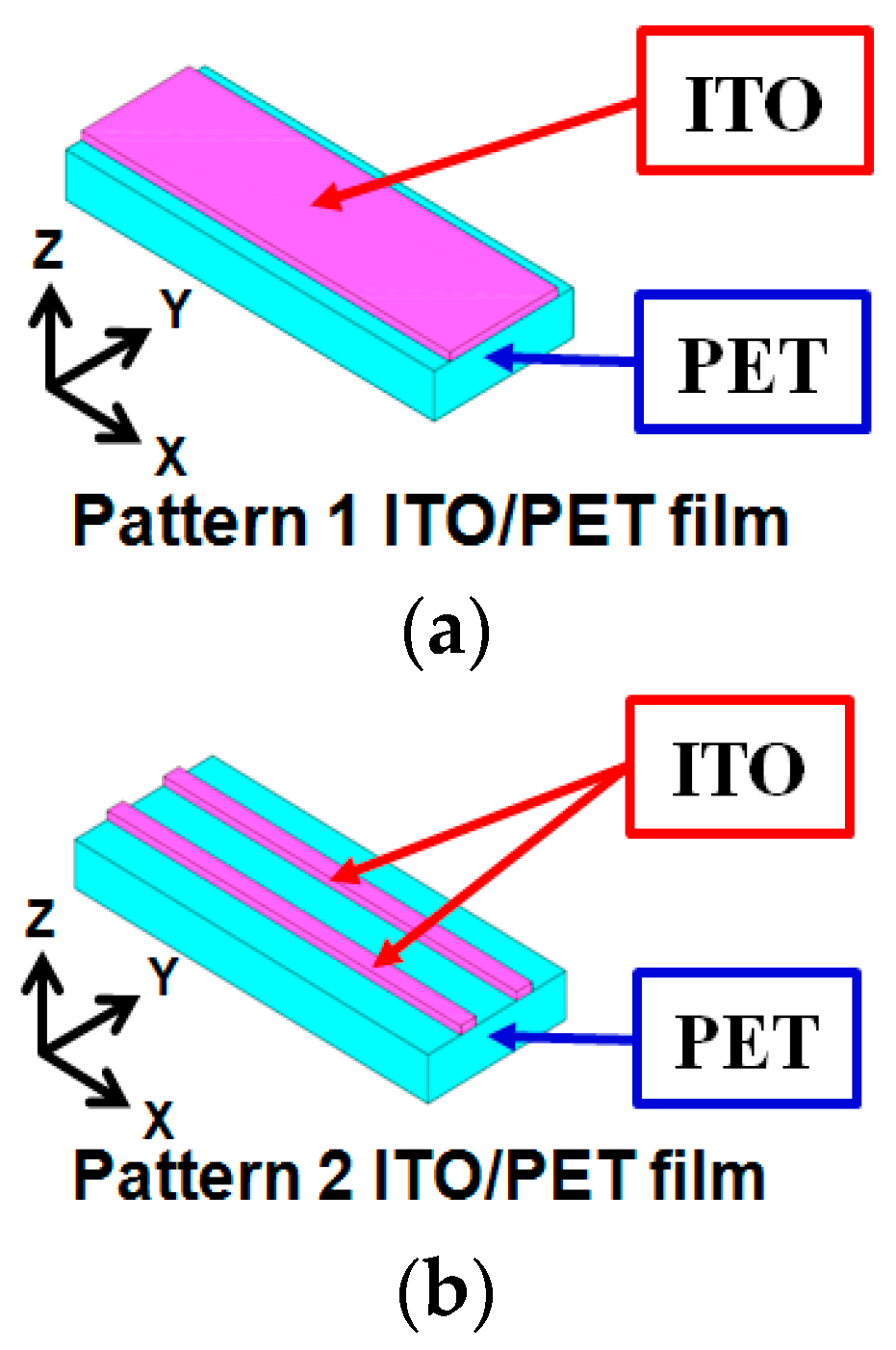

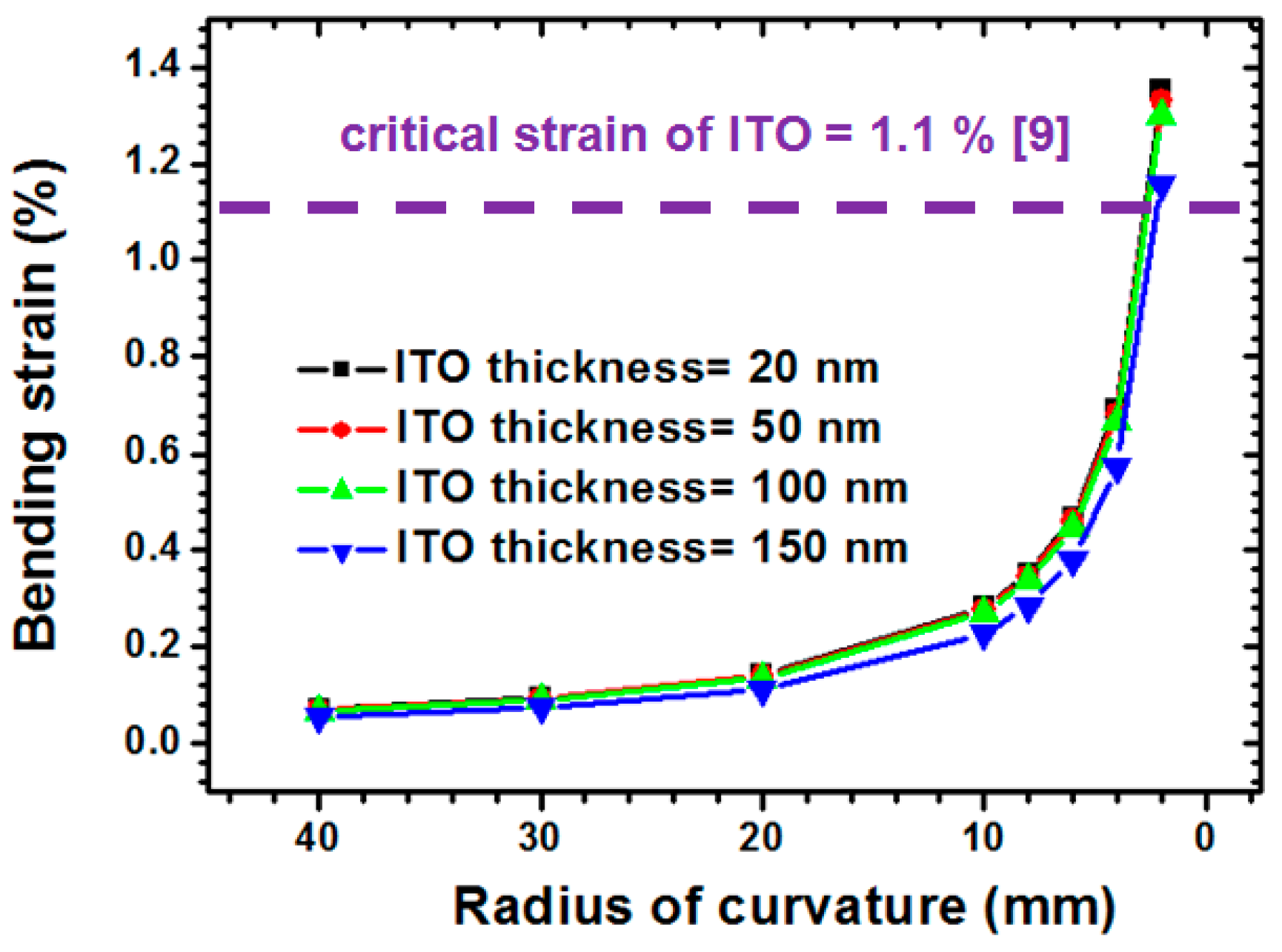
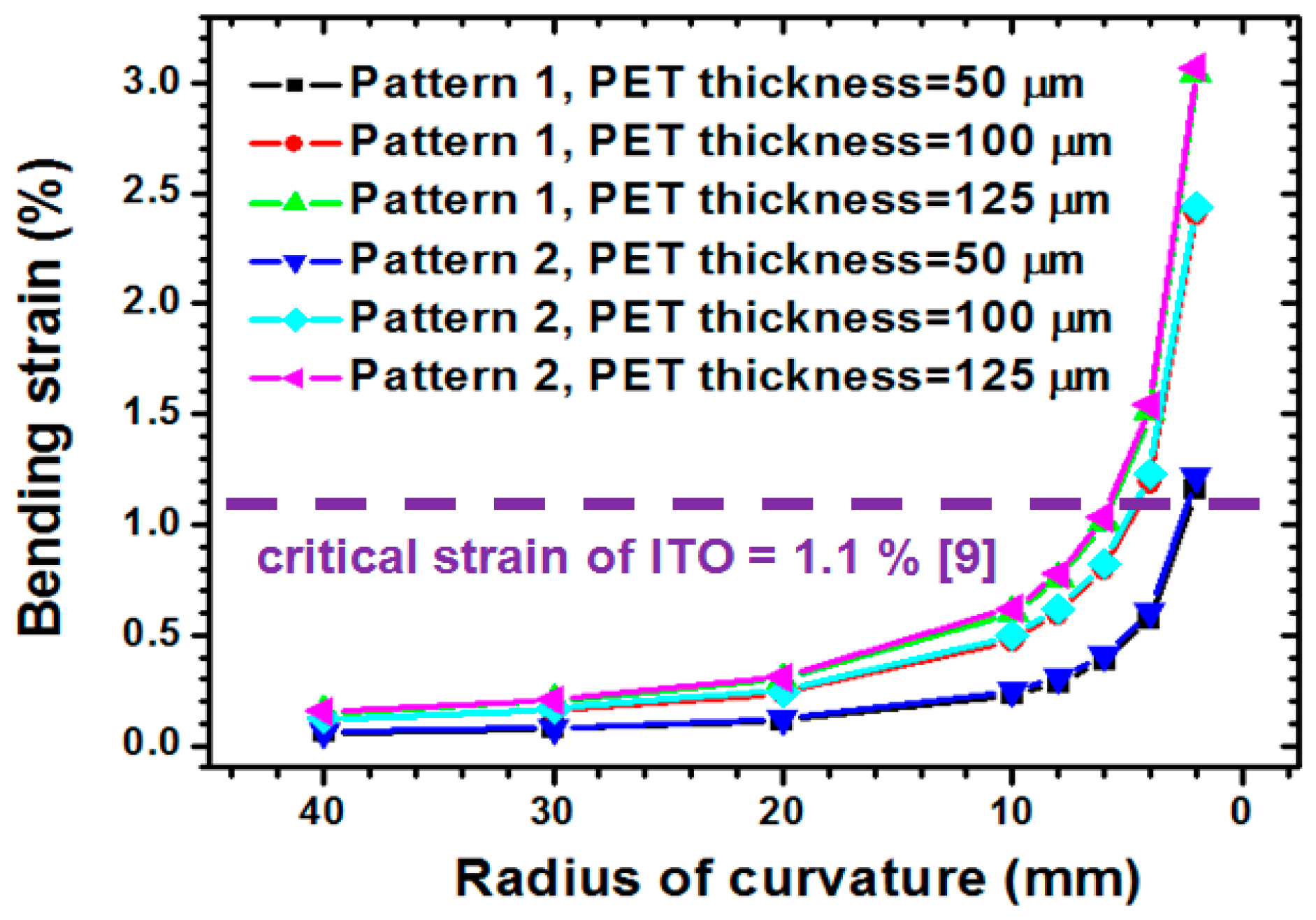
| PET Thickness | Sheet Resistance | Pattern 1 | Pattern 2 | ||
|---|---|---|---|---|---|
| Cal. (kΩ) | Mea. (kΩ) | Cal. (kΩ) | Mea. (kΩ) | ||
| 50 µm | 120 ± 20 Ω/ϒ | 3.02–4.23 | 3.57 | 8.78–12.29 | 10.15 |
| 100 µm | 140 ± 30 Ω/ϒ | 3.33–5.14 | 4.26 | 9.66–14.92 | 10.67 |
| 125 µm | 150 ± 30 Ω/ϒ | 3.63–5.44 | 4.95 | 10.53–15.80 | 13.03 |
| Experimental Conditions | Radius of Curvature (mm) | |||||||
|---|---|---|---|---|---|---|---|---|
| 2 | 4 | 6 | 8 | 10 | ||||
| Convex Bending | ||||||||
| Pattern Design | Pattern 1 (Line width = 3.92 mm) | Pattern 2 (Line width = 0.37 mm) | ||||||
| PET Thickness (μm) | 50 | 100 | 125 | |||||
© 2016 by the authors; licensee MDPI, Basel, Switzerland. This article is an open access article distributed under the terms and conditions of the Creative Commons Attribution (CC-BY) license (http://creativecommons.org/licenses/by/4.0/).
Share and Cite
Lee, C.-C.; Huang, P.-C.; Wang, K.-S. Flexural Capability of Patterned Transparent Conductive Substrate by Performing Electrical Measurements and Stress Simulations. Materials 2016, 9, 850. https://doi.org/10.3390/ma9100850
Lee C-C, Huang P-C, Wang K-S. Flexural Capability of Patterned Transparent Conductive Substrate by Performing Electrical Measurements and Stress Simulations. Materials. 2016; 9(10):850. https://doi.org/10.3390/ma9100850
Chicago/Turabian StyleLee, Chang-Chun, Pei-Chen Huang, and Ko-Shun Wang. 2016. "Flexural Capability of Patterned Transparent Conductive Substrate by Performing Electrical Measurements and Stress Simulations" Materials 9, no. 10: 850. https://doi.org/10.3390/ma9100850





